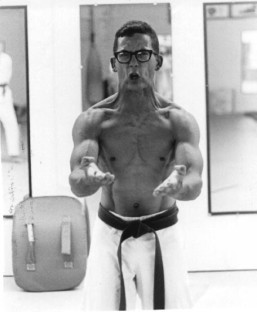An Internal pattern in Taekwon-do by Stuart Anslow, IV |
I recently did a poll asking "Should Taekwon-do have an internal pattern like "Sanchin"? (moreso with the kihaps
now)" and was surprised a little by how many answered "whats an internal pattern". I considered adding this kata to my own stable of the patterns a few years back (before any ITF spoke of adding the kihaps), due to Taekwon-do lacking in a pattern/kata of this type - an internal pattern for developing internal energy. Its a kata from Goju Ryu (amongst other styles) and it is used to develop "Ki" amongst other things. Ki being part of the makeup of a true Kihap! I thought of the poll question purely as ITF-C have insitigated kihaps within patterns and because "Kihaps" are a training method to devleop Ki. However, simply shouting in a pattern doesnt do that, hence other training methods are used (Dan-Jun breathing being one) to increase "Ki" and thus, then it can be utilized properly both at the correct point in the pattern, but more importantly for the correct reason & useage. Kihap is the Korean term for Kiai*: "Kiai appears to be a compound of ki meaning mind, breath or spirit and ai, a stem of the verb awasu, "to unite"; therefore literally "concentrated or united spirit". " "Ki" is the Korean/Japanese term for "Chi", also refered to as "prana" in Yoga circles - so in the following extracts, each of these terms describe the same thing and are inter-changeable. Though there are other kata that may do this, 'Sanchin' is widely regarded as the top kata in this area for the devlopment of Ki, and with some Taekwon-do students now performing Kihaps in their patterns it seems an ideal opportunity for instructors and perhaps even the whole association to utilize this and take it a few steps further perhaps into actually developing Ki energy, rather than kihaping as a historical footnote, with little relevance to its actual usage in martial arts. Back Ground Info on Sanchin * Only one stance is used—the sanchin (meaning "three battles") stance, from which a name of the kata is derivative, now Sanchin-dachi is a practical stance, and yet is the most difficult stance to master. The legs protect the body from sweep kicks, the thighs are to trap low kicks. According to a tai chi manual ("Zhengzi 13 postures"), the punch draws its power from the earth through the legs—the flip of the hips enables the strength of the whole body to be channeled and focused into one punch. Properly employed, Sanchin kata follows the "hard" style of karate—all the muscles are to be flexed and tensed throughout the kata—actually making it the most strenuous kata. This type of strength training, is only recently understood in Western science and is known as "isometric training" in bodybuilding. In Chinese training, Sanchin kata also introduces the student to the use of "qi" (Japanese "ki") for training and fighting applications. It can be understood to be a form of "qigong" as employed in Chinese Wushu. Many western interpretations of qi/ki explain it as an enhanced understanding of internal body dynamics and muscle control through repeated and strenuous training. Qigong * Qigong (or ch'i kung) refers to a wide variety of traditional cultivation practices that involve methods of accumulating, circulating, and working with Qi or energy within the body. The qi in qigong means breath or air in Chinese, and, by extension, life force, dynamic energy or even cosmic breath. * Info edited from Wiki (as it explains it better than I can) For those who own "Ch'ang Hon Taekwon-do Hae Sul" there is a whole section that explains Ki, its relationship within Taekwon-do and the Ki points of the Kup patterns |
